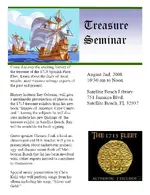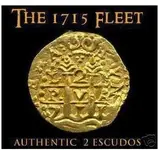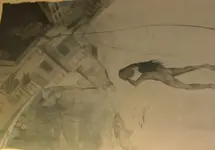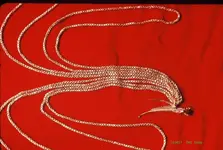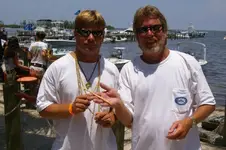My bad...it appears the Ais disappeared in the later half of the 18th century. Enjoy:
Homer Cato of Micco is an amateur ar-
chaeologist who has documented evi-
dence of what may have been Sebastian's
earliest neighborhood.
The "Cato Site" is located just south of
Sebastian Inlet and north of McLarty
Museum.
What he found there was the skeletal
remains of three Indians who had lived
in the area hundreds of years before the
time of Christ.
A pounder made of the central co-
lumella of a conch shell and located near
the remains was carbon dated to 845
B.C. The remains, as Cato noted later in
an interview I did with him, were sev-
eral feet below the level at which the co-
lumella had been found and may have
been thousands of years older.
However, we can state with some certainty that
there were Indians living there almost 3,000
years ago.
Midden material and other artifacts located at
the site indicate it was the location of a village.
By comparing the remains with others he had
found in and around the Sebastian area, Cato was
able to confirm that they were related to the Ais
Indians, the dominant tribe on this part of the
Florida east coast when the Spanish arrived.
He also suspects there was a natural inlet be-
tween the Indian River and the Atlantic Ocean in
the area at that time, which might account for the
Indians' decision to locate a village there.
The Ais Indians were related to the Caribbean
tribes. Hunter-gatherers, they lived on the abun-
dance of marine life and wild fruits and berries
indigenous to the area.
They dominated the Florida coast from Fort Pierce
to Cape Canaveral, and the Indian River was their
principal source of food and transportation.
With a marine-based economy, the Ais relied on
the lagoon, the river and the ocean for food. Many
of their tools, implements and decorations were
made of shell.
Later, after Europeans had discovered the new
world, they came to rely on the sea for other
ings as well.
With the advent of the Spanish treasure
fleets, which left Cuba and sailed parallel
to the Florida coast to a point east of St.
Augustine before striking across the At-
lantic Ocean for Spain, the Ais became
treasure salvors as well.
Numerous shipwrecks along the
coast attracted the interest of the
Ais. Those shipwrecks ultimately
brought them into contact with the
Spanish, a contact that would prove
fatal for the Indians and their cul-
ture.
For as the Indians preyed upon
the Spanish vessels wrecked by
storms along the coast, the Span-
ish began to prey upon them.
In 1565 Admiral Pedro Menendez
of Spain was given a charter to
develop the east coast of Florida.
One of his first tasks was to clear
out the French colony that had been
established by Jean Ribault at Fort
Caroline.
With ruthless efficiency, Menen-
dez slaughtered the French. After
capturing them, he had them led
out in groups often and had their
throats cut.
After learning the location of a group who had
escaped, Menendez came down the coast from St.
Augustine to Cape Canaveral where the French-
men had made a rough fort.
He captured the French and continued on down
the coast with his expedition.
In his book about Menendez and the Spanish
Conquest of Florida in 1565-68, _The Enterprise of
Florida_, historian Eugene Lyon describes the jour-
ney.
"As his land forces, swollen by the number of the
French prisoners, slogged along the long expanse of
beach which stretches like a crescent moon south-
ward from Cape Canaveral, the adelantado of Flor-
ida entered a new and distinctive part of his king-
doms. As the marching men moved down the nar-
rowing island they soon caught glimpses of the
broad open waters of the Indian River. Menendez
could quickly see that the waterway would afford
protected navigation by small craft which would
enable more rapid and secure communication along
the central east coast."
Menendez made his way down the coast to a place
where the "...land between river and ocean was a
mere sandspit." There he found a thick cluster of
Indian villages and the dwelling place of the chief
of the Ais.
The location of this site is believed to have been
near the St. Sebastian River area.
According to Lyon, "The basic theory of the loca-
tion of the Ais culture center was developed by
Homer N. Cato of Micco, Florida, who has done
much fruitful field work in a number of Ais sites in
the vicinity of the St. Sebastian River and the ocean
inlet opposite it."
As he had marched his troops down the beach from
Cape Canaveral, Menendez had been followed by
three boats at sea. Having established contact with
the Ais chieftain, the adelantado had his men make
camp at a location not far from the Ais village.
Leaving 200 of his soldiers and 50 of the French
prisoners at that location, he boarded his boats and
set sail for Havana in search of reinforcements and
more supplies for his venture in Florida.
According to Cato, the evidence indicates the loca-
tion of the seat of Ais culture at that time was near
the present location of Sebastian and Roseland.
The relationship between
the Spanish and the Ais
Indians alternated be-
tween efforts to negotiate
and hostility, which led at
times to massacres of the
Indians by the Spanish.
For their part, the Span-
ish colonists were con-
cerned about the safety of
their missionaries and of
shipwreck victims along
the coast. The Indians' pre-
dilection for harvesting treasure from the many
shipwrecks also was a matter of concern.
The Indians, on the other hand, were accustomed
to harvesting the bounty of the sea, and doubtless
regarded the ornaments and jewelry they salvaged
as one more example of that bounty.
They had little reason to regard the powerful,
pale-skinned interlopers with anything but suspi-
cion.
Here in Florida, as in other parts of' the new world,
the relationship between the Indians and the
Europeans who came to live on lands they had
occupied for generations was strained and eventu-
ally led to the extermination of the Indian
cultures.
At the time Menendez visited the chief of the
Ais, the Indians still had a viable culture. But
clearly it was one whose time was running
out.
In 1605 a Spanish soldier named Aivero
Mexia was sent to improve relations with the
Ais.
Mexia kept a journal of his trip down the
Indian River, and from the notes in that
journal, one of the first maps of the Indian
River lagoon was made. The map includes
what may be the earliest record of the St.
Sebastian River, as it was called by the Span-
ish.
At any rate, the Ais were still in the area
during the early 1700s when one of the most
famous of all shipwrecks occurred.
The Sinking of a Treasure Fleet
More than any other event, it was the sink-
ing of the 1715 Spanish Plate Fleet off the
coast of Florida that gave the Treasure Coast
its name.
After leaving Havana in late July, a fleet of
12 ships were driven by a hurricane into the
Florida coast between St. Lucie Inlet and the pres-
ent location of Sebastian Inlet.
Eleven of the ships sank. The twelfth, a French
vessel that had been forced to sail with the Spanish
when they left Havana, managed to escape the
reefs and to survive the encounter with the storm.
It was July 31, 1715. Thousands perished in the
catastrophe.
Almost immediately, the Spanish launched a sal-
vage operation. The men, women and children who
had survived were herded up the coast to a location
just south of the modern-day Sebastian Inlet, the
northernmost point at which the ships were known
to have gone down.
The survivors were placed in the location of an Ais
Indian village, were they would wait until trans-
portation could be arranged to return them to
Havana.
McLarty Museum, a part of the Sebastian Inlet
State Recreation Area, is located on the site of the
survivors camp.
Under the direction of Don Juan del Hoyo
Solorzano, the sergeant major of Havana, the sal-
vage operation recovered much of the treasure that
had been lost when the Plate Fleet went down.
In 1716, Captain Henry Jennings raided the sal-
vors' camp and made off with 21 tons of silver
pieces-of-eight, about 600,000 coins. Jenning's raid
touched off a wave of piracy in the Caribbean.
However, not all of the treasure was recovered by
the Spanish, nor was all they recovered captured by
pirates.
By the last half of the
1700s, the Ais were gone
completely. Possibly some
of the scattered remnants
merged with the outcasts
from other tribes who
began coming to Florida
during that time.
Little is known of the ul-
timate fate of the Ais.
They had been hunted
and enslaved or killed by
the Spanish. They also
had succumbed, like most
native American tribes to
many of the white man's
illnesses.
But they left their mark on the countryside in the
form of giant shell middens that dotted the shores
of the St. Sebastian River and the Indian River
lagoon where their villages had been located.
The middens were a pre-Columbian landfill, giant
refuse heaps containing shell, pottery shards, bro-
ken tools and all the other castoff material of a vital
culture.
In some cases the middens became the site of
villages. In others, they were burial grounds.
One of the middens became a landmark for some
time in the Sebastian area before it was finally
destroyed early in this century.
Christened Barker's Bluff, after an Indian trader
who was supposedly killed there in the mid-1800s,
the midden was more than 1,000 feet long, about
400 feet wide and as high as the tallest palm tree in
the area.



